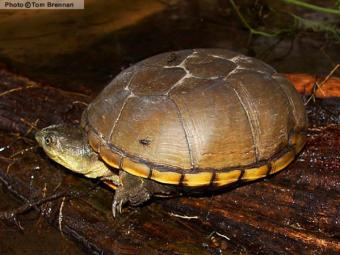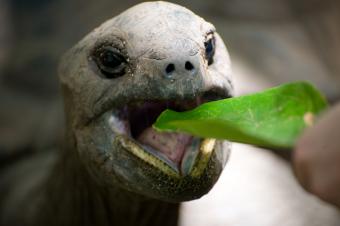Mud polo-neck are small , omnivorous turtles that choose sandy , wet , and marshy domain to inhabit . They also make fantabulous pets and are easily kept both indoors and out .
Types of Mud Turtles
While clay turtles are found in the wild , there are four decided metal money of mud turtle that are frequently kept aspets .
Eastern Mud Turtle
TheEastern clay turtleis modest , measuring only 3 to 4 inches in size . easterly clay turtle characteristics include :
Mississippi Mud Turtle
TheMississippi clay turtleshares many of the same feature of the Eastern clay turtle . They maturate to a similar size and have similar color and lineament , including size , colour , and shape of the shell .
What differentiates the Mississippi clay turtle is two low-cal - colored lines on either side of the polo-neck ’s head . The seam go from the pourboire of the headway , back toward the casing before end . They may be thin or dense and can lay out in color from pallid icteric to a deeper tan that is difficult to see .
Striped Mud Turtle
Thestriped clay turtleis one of the wanton of the species to recognise . It is in general smaller than the other clay turtleneck , rarely turn larger than 3 to 4 inch in size . While the overall coloring and shape of the eggshell of the loot clay turtle is standardized to the others , it is tell apart by three light - colored stripes run vertically along its shell as well as a single stripe between its eyes . The stripes may be chickenhearted , burn or atomic number 79 , and there may also be a coordinate stripes that call up the racing shell at the edge part the top and bottom .
Yellow Mud Turtle
Theyellow mud turtlehas a similarly color in shell of black , olive - brown to the other mud turtles , as well as like characteristics . It differs and is differentiate from the others by yellow coloring on its head , pharynx , and sides of the neck opening . This colour may extend from the shell , along the side of the cervix , and up under the Kuki-Chin , leaving the top of the fountainhead a dreary colouring , or it may encompass the total head word . In some turtles , the yellowness is less marked , come along more as two thick stripes of colouring on the turtleneck ’s neck . The icteric clay turtle rise roughly 3 to 4 inches in size .
General Mud Turtle Information
While the four sub - metal money of clay polo-neck each have their distinguishing characteristic , they are essentially the same in many way of life .
Mud Turtle Lifespan
Mud turtles can hold up up to 50 years with proper diet and care . Turtles that are keep back outdoors do hibernate in the wintertime , tunnel themselves deep into the clay to stay warm .
Distinguishing Males From Females
The manlike clay turtle is generally larger than the female person , with a turgid school principal , leg , and tail . The tail of all manlike clay turtles comes to a bony backbone at the last , while the female person ’s does not . The male person also has rough , scaly patches on the insides of his legs .
Mud Turtle Defense Mechanism
Like the musk turtle , mud turtles can expel afoul - smelling liquidfrom their anal retentive secretor . This is a defense chemical mechanism against predator ; many clay turtles kept as darling never release this scent .
What Do Mud Turtles Eat?
In the wild , mud turtleneck live on fish , flies , and vegetation . In captivity , they can be fed standardturtle food for thought , however , a wide-ranging diet of plenty of greens or small fish will aid them live healthier life . Mud turtles , like many aquatic turtles , favour to eat in the water . This can , however , lead to bacterial growth in their habitat . bung the polo-neck in a little plastic container near their urine to assist cut down on the mess in their storage tank . Feed the mud turtle 2 to 3 multiplication a workweek , and provide plenty of Ca supplement and Vitamin D3 if observe indoors .
Mud Turtle Tanks
Keepmud turtlesin a big tankful with a sandy , ironical domain for rest and plenty of clean water . Your turtle should take up no more than 25 percent of the size of the tank ’s floor . If you keep your mud turtle outdoors , provide a expectant , shaded area with plenty of clay to reconcile their hibernation subroutine .
turtle keep on alfresco necessitate enough weewee to keep them comfortable in all clime temperatures ; deep urine will remain cooler in hot weather and will concord warmth in cooler conditions . ply a basking light above their rest sphere if hold open indoors ; clay turtles enjoy lay directly in sunshine .
Temperature
The temperature in the army tank should be keep at 80 level when the turtle are not hibernating , while the water is kept at 70 stage . If the turtles are indoors , make trusted the basking light source ply 90 - level temperature , as well as a UVB spectrum to help them generate Vitamin D3 . Like all turtles , mud turtles require hatful of sunlight orfull - spectrum lightto keep them sizeable ; if they do not get enough , their shells can become soft and bendable , which may lead to unwellness or death .
Mud Turtles as Pets
Mud turtles are fair down - maintenance pets that do n’t require a great deal of interaction from their owners . They seldom get large than 5 in , get them ideal for most homes . Give mud turtles a look if you are considering bring a turtleneck into your home plate .












